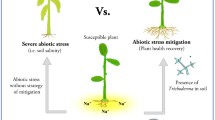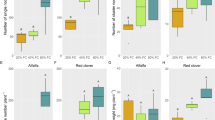Abstract
The interaction between physiological stress and arthropod herbivory was studied using two perennial species of Hypericum. Seedlings of H. perforatum, a herb introduced to Australia and weedy in places, and H. gramineum, an indigenous species, were subjected to water stress and/or herbivory by a mite, Aculus hyperici and an aphid, Aphis chloris. Both arthropods have recently been released in Australia for biological control of H. perforatum. Individually, stresses reduced measures of plant growth. Combinations of the three stresses decreased plant growth by slightly more than the product of their separate effects, suggesting that there is a weak positive interaction exacerbating the damage caused by each stress. Seedlings of the target weed and the ‘non-target’ indigenous species were equally affected by the arthropods. The implications for weed biological control are discussed.
Similar content being viewed by others
References
Abacus Concepts Statview (1992) Statview: the ultimate integrated data analysis and presentation system. Abacus Concepts, Berkeley
Andres (1981) Conflicting interests and the biological control of weeds. In: Delfosse ES (ed) Proceedings of the V International Symposium on Biological Control of Weeds, July 22–27, 1980, Brisbane, Australia. CSIRO, Melbourne, pp. 11–20
Bastow Wilson J (1988) A review of evidence on the control of shoot: root ratio, in relation to models. Ann Bot 61: 433–449
Bernays EA, Lewis AC (1986) The effect of wilting on palatability of plants to Schistocerca gregaria, the desert locust. Oecologia 70: 132–135
Briese DT (1989) Host-specificity and virus-vector potential of Aphis chloris (Hemiptera: Aphididae), a biological control agent for St. John's wort in Australia. Entomophaga 34: 247–264
Christiansen TA, Lockwood JA, Powell J (1989) Effects of arthropods on root: shoot ratio and biomass production in undisturbed and modified mountain shrub habitats. Great Basin Nat 49: 456–460
Cockfield SD, Potter DA (1986) Interaction of euonymus scale (Homoptera: Diaspidae) feeding damage and severe water stress on leaf abcission and growth of Euonymus fortunei. Oecologia 71: 41–46
Crawley MJ (1989) Insect herbivores and plant population dynamics. Annu Rev Entomol 34: 531–64
Crawley MJ, Pattrasudhi R (1988) Interspecific competition between insect herbivores: asymmetric competition between cinnabar moth and the ragwort seed-head fly. Ecol Entomol 13: 243–249
CSIRO (1991) The host-specificity of Aculus hyperici (Liro) (Acarina: Eriophyidae) in relation to different species in the genus Hypericum (CSIRO application to the Australian Plant Quarantine and Inspection Service) CSIRO, Canberra
Digby P, Galwey N, Lane P (1989) Genstat 5, A Second Course. Oxford University Press, Oxford
English-Loeb GM (1989) Nonlinear responses of spider mites to drought-stressed host plants. Ecol Entomol 14: 45–55
English-Loeb GM (1990) Plant drought stress and outbreaks of spider mites: a field test. Ecology 71: 1401–1411
Feeney P (1976) Plant apparency and chemical defence. In: Wallace JW, Mansell RL (eds) Biochemical interaction between plants and insects, vol. 10. Plenum Press, New York, pp 1–40
Gershenzon J (1984) Changes in the levels of plant secondary metabolites under water and nutrient stress. Recent Adv Phytochem 18: 273–300
Groves RH (1989) Ecological control of invasive terrestrial plants. In: Drake JA et al. (eds) Biological invasions: a global perspective. John Wiley & Sons, New York, pp 437–461
Groves RH, Williams JD (1975) Growth of skeleton weed (Chondrilla juncea L.) as affected by growth of subterranean clover (Trifolium subterraneum L.) and infection by Puccinia chondrillina Bubak & Syd, Aust J Agric Res 26: 975–83
Harris P (1980) Stress as a strategy in the biological control of weeds. In: Papavizas GC (ed) Biological control in crop protection (BARC Symp. 5). Granada, London
Holtzer TO, Archer TL, Norman JM (1988) Host plant suitability in relation to water stress. In: Heinrichs EA (ed) Plant stress-insect interactions. John Wiley & Sons, New York, pp 111–138
Jeppson LR, Keifer HH, Bahr EW (1975) Mites injurious to economic plants. University of California Press, London
Karban R, Strauss SY (1993) Effects of herbivores on growth and reproduction of their perennial host, Erigeron glaucus. Ecology 74: 39–46
Kozlowski TT (1979) Tree growth and environmental stress. University of Washington Press, Seattle
Krantz GW (1978) A manual of acarology. Oregon State University Book Stores, Corvallis
Landsberg J (1988) Dieback of rural eucalypts: tree phenology and damage caused by leaf-feeding inects. Aust J Ecol 13:251–267
Landsberg J (1990) Dieback of rural eucalypts: the effect of stress on the dietary nutritional quality of foliage. Aust J Ecol 15:97–107
Landsberg J, Wylie F (1983) Water stress, leaf nutrients and defoliation: a model of dieback of rural eucalypts. Aust J Ecol 8:27–41
Lane P, Galwey N, Alvey N (1987) Genstat 5: an introduction. Clarendon Press, London
Larsson S (1989) Stressful times for the plant stress-insect performance hypothesis. Oikos 56:277–283
Louda SM, Collinge SK (1992) Plant resistance to insect herbivores: a field test of the environmental stress hypothesis. Ecology 73:153–169
Mattson WJ (1980) Herbivory in relation to plant nitrogen content. Annu Rev Ecol Syst 11:119–61
Mattson WJ, Haack RA (1987a) The role of drought in outbreaks of plant-eating insects. BioScience 37:110–118
Mattson WJ, Haack RA (1987b) The role of drought stress in provoking outbreaks of phytophagous insects. In: Barbosa P, Schultz JC (eds) Insect outbreaks. Academic Press, San Diego
Mitchell HL, Chandler RF (1939) The nitrogen nutrition and growth of certain deciduous trees of northeastern United States. Black Rock For Bull 11:94
Mopper S, Whitam TG (1992) The plant stress paradox: effects on Pinyon sawfly sex ratios and fecundity. Ecology 73:515–525
Morris WF (1992) The effect of natural enemies, competition, and host plant water availability on an aphid population. Oecologia 90:359–365
Myers BJ, Landsberg JJ (1989) Water stress and seedling growth of two eucalypt species from constrasting habitats. Tree Physiol 5:207–218
Piene H (1978) Effects of increased spacing on carbon mineralisation and temperature on young fir. Can J For Res 8:398–406
Rhoades DF (1983) Herbivore population dynamics and plant chemistry. In: Denno RS, McClure MS (eds) Variable plants and herbivores in natural and managed systems. Academic Press, New York, pp 155–220
Stewart GR, Lahrer F (1980) Accumulation of amino acids and related compounds in relation to environmental stress. In: Miflin BJ (ed) Biochemistry of plants vol. 5. A comprehensive treatise on amino acids and derivatives. Academic Press, New York, pp 609–635
Turner CE (1985) Conflicting interests and biological control of weeds. In: Delfosse ES (ed) Proceedings of the VI International Symposium on the Biological Control of Weeds, 19–25, August 1984, Vancouver, Canada Ministry of Supply Services, Ottawa, pp 203–225
Vranjic JA, Gullan PJ (1990) The effect of a sap-sucking herbivore, Eriococcus coriaceus (Homoptera: Eriococcidae), on seedling growth and architecture in Eucalyptus blakelyi. Oikos 59:157–162
Wagner MR, Frantz DP (1990) Influence of induced water stress in ponderosa pine on pine sawflies. Oecologia 83:452–457
Waring GL, Cobb NS (1992) The impact of plant stress on herbivore population dynamics. In: Bernays E (ed) Insect-plant interactions vol. 4. CRC Press, Boca Raton, pp 167–226
Waring GL, Price PW (1990) Plant water stress and gall formation (Cecidomyiidae: Asphondylia spp.) on creosote bush. Ecol Entomol 15:87–95
Wearing CH (1967) Studies on the relations of insect and host plant. 2. Effects of water stress in host plants on the fecundity of Myzus persicae (Sulz.) and Brevicoryne brassicae (L.). Nature 213:1052–1053
Wearing CH, Emden HF van (1967) Studies on the relations of insect and host plant. 1. Effects of water stress in host plants on infestation by Aphis fabae Scop., Myzus persicae (Sulz.) and Brevicoryne brassicae (L.). Nature 213:1051–1052
White TCR (1969) An index to measure weather-induced stress of trees associated with outbreaks of psyllids in Australia. Ecology 50:905–909
White TCR (1984) The abundance of invertebrate herbivores in relation to the availability of nitrogen in stressed food plants. Ecologia 63:90–105
Author information
Authors and Affiliations
Rights and permissions
About this article
Cite this article
Willis, A.J., Ash, J.E. & Groves, R.H. Combined effects of two arthropod herbivores and water stress on growth of Hypericum species. Oecologia 96, 517–525 (1993). https://doi.org/10.1007/BF00320509
Received:
Accepted:
Issue Date:
DOI: https://doi.org/10.1007/BF00320509




